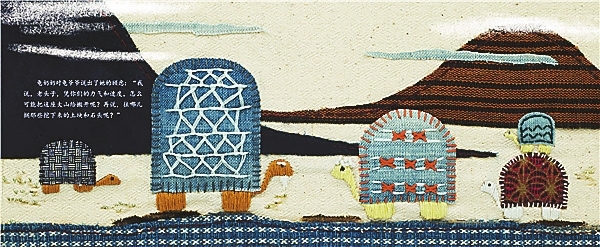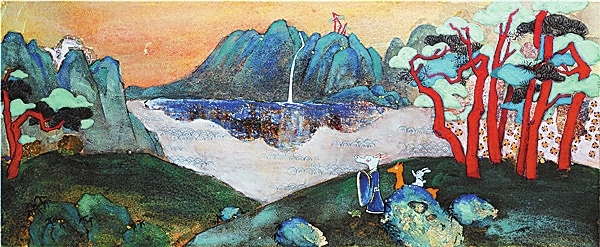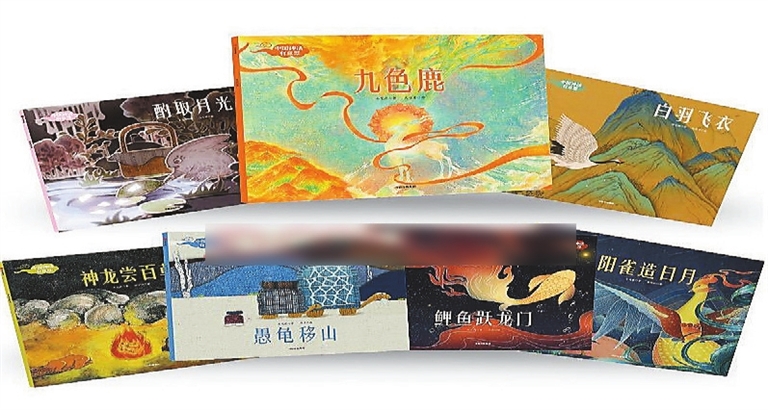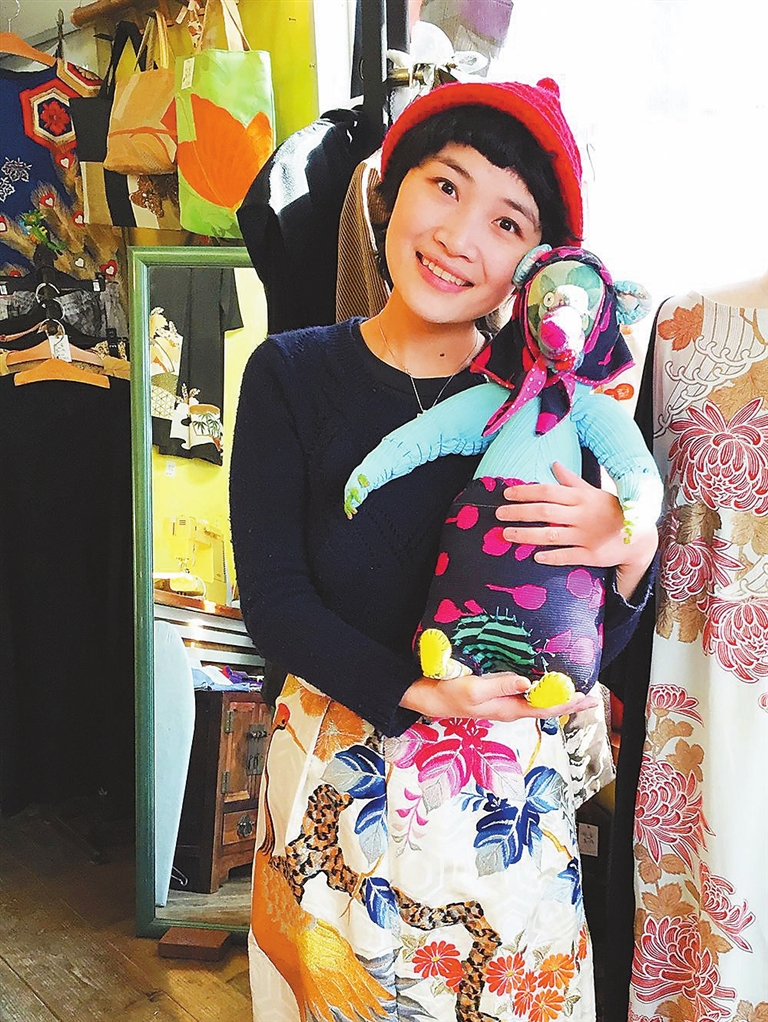




ANCIENT Chinese legends have inspired generations. To make them more appealing, a group of seven picture book creators, with an average age of 25, have given ancient tales a modern makeover. Guided by their mentor Mou Aili, associate professor at the School of Animation with Sichuan Fine Arts Institute in Chongqing, they have turned their graduating works into a collection of seven picture books. The collection, entitled “Interesting Chinese Mythology,” was published by China Citic Press in May, and has been hailed by both critics and readers as “original and refreshing.” More than 6,000 copies have been sold so far. Next month, the Chongqing Library will hold an exhibition featuring the illustrations in the collection. Mou penned the text of the books. “It’s interesting to see how these young illustrators combine the ancient with the modern, and Chinese aesthetics with internationalized expressions, and above all, how they view and make use of tradition,” she said. Apart from familiar tales like “A Carp Leaping the Dragon Gate,” the collection also take in stories of ethnic groups — “The Yangque Bird Creating Sun and Moon” from the Miao and “White Feathered Flying Suit” from the Dongxiang. Editor of the collection Yu Zhixiao says she’s impressed by the young people’s powerful creations. Xiao Peirou, one of the seven, was initially unimpressed by its seemingly “insignificant” nature, thinking of the picture book idea as being childish. After some research, however, she found good-quality Chinese mythology picture books were rare, and “there was much room to improve and new trails to blaze.” Xiao and others began exploring different approaches and experimented with a variety of mediums and techniques. For one, the team transformed human characters into anthropomorphic animals, as was suggested by Mou. For instance, in “A Deer of Nine Colors” illustrated by Xiao, the ungrateful villain is portrayed as a red fox, while the queen who covets the deer’s fur is illustrated as a peacock. For the same book, the team applied the “gold-bluish green landscape” style of Chinese ink painting that uses gold, green and cyan as the three major colors. Moreover, Xiao added a stereoscopic touch of light to the ancient visual effects via Photoshop, and images of the fairylike deer galloping in the green hills, bathed in the sunlight, came to life. It was a long process of trial and error to achieve the best effect, and her effort paid dividends. Her artworks have been shortlisted in the cartoon category for the 13th National Exhibition of Fine Arts, sponsored by the China Artists Association, and exhibited last year among more than 1,000 creations in Guangzhou, Guangdong Province. Xiao felt even more delighted when she met crowds of preschool kids and primary school students who came to see the exhibition of graduation works at her school last year. Upon hearing them raise questions and commenting on her work with passion, she felt a great sense of fulfillment. “At that time I suddenly realized I was doing something great ... that, with the good work I presented, I have planted a seed of art appreciation in the young hearts of our future generation,” she said. Another graduate, Qiu Fangxu, can’t remember how many silver foils he ruined while ironing them with sulfur to get the ideal mixture of color he wanted for the picture book, “The Magic Dragon and the Herbal Medicines.” “The speed, the pressure applied and even my breathing mattered a lot, because the foils are so light and thin. I spent seven whole days last year, repeatedly ‘burning’ the silver,” said Qiu, who applied another unique technique, yancaihua (meaning “rock color painting”), by learning while experimenting and practicing countless times. It was a lost art form in China for over 1,000 years. Using mineral pigments made from rock and earth, it colored the murals in the grottoes of Dunhuang, Gansu Province. Its heyday was during the Tang Dynasty (618-907), but it lost its appeal during the Song and Yuan dynasties (960-1368) as Chinese artists adopted ink as their preferred medium, according to Wang Xiongfei, head of the Rock Painting Research Center at the China Academy of Art. It is only in recent decades that artists have rediscovered its charm and revived the technique. The glittering particles, the wild colors and the layers of texture are what drew Qiu and his peers to it. A student of ink painting, Qiu felt an “emotional bond” with these traditional colors, so it was natural for him to apply them to his work, a tale about Shennong, one of the three great mythical emperors who is said to have been first to develop agriculture and herbal medicines. In Qiu’s interpretation, the human emperor Shennong is portrayed as a dragon. Mou offered the Magic Dragon a coming-of-age character arc. In the tale, the dragon overcomes setbacks to grow into glorious maturity and finally soar. “The cool idea of the image transformation sparked my passion and desire, and I believe young readers will love it as much as I did,” Qiu says. Mou keeps drawing inspiration from Chinese cultural traditions, and believes careful plans and smart thinking are the ways to help revive traditions and attract modern readers. She has been teaching for over a decade, after obtaining a bachelor’s degree in drama literature and a Ph.D in theater and Chinese traditional opera from the Central Academy of Drama, and her master’s degree from Sydney University. She has noticed that more students have begun to embrace guofeng, meaning Chinese-style trends, spurred on by both mainstream entertainment and social media platforms. “As our society gets wealthier, it’s natural that the young people have reclaimed greater pride and confidence in their own cultural roots,” Mou said. Mou encourages her students not to merely repeat ancient artistic expressions, but to try and find something new. Liang Yuan, creator of “A Carp Leaping the Dragon Gate,” depicted ocean waves using “traditional patterns like cirrus clouds,” which gave her a new outlet to demonstrate her skills. In “The Yangque Bird Creating Sun and Moon,” Zhang Yuting married Art Deco patterns with images of a phoenix, while in “White Feathered Flying Suit,” Zhang Xinyu adapted gongbi paintings, a classic Chinese style employing meticulous brush strokes, to provide the elaborate backgrounds for her Tang-Dynasty era characters. Her blending of classy and cute made the story fun fodder for young readers. In another tale, about a rabbit trying to scoop the reflection of the moon out of water with lotus leaves, Wang Meiling chose to draw the figures and backgrounds, cut them out and recorded their movements on film to achieve a 3-D effect. And, for the well-known tale, “Yugong Moves the Mountain,” Zhou Lan depicted the protagonist as a turtle instead of an old man. All her figures and settings were fashioned from cloth and employ traditional Chinese dyeing and weaving skills. She said it took five months to finish the 20 paintings of cloth art, adding: “I hope to show younger readers more dimensions to traditional Chinese arts, such as handicrafts.” Zeng Zirong, an art publisher, writer and head of Citic Art Museum, said it’s important for artists to keep an open mind and create stylish books that adapt ancient Chinese culture with a modern appeal. “As artists feel more confident in their national heritage, they can keep one foot in their tradition, while the other advances onto the world stage.” (China Daily) | 
